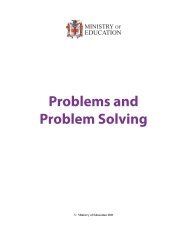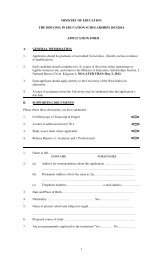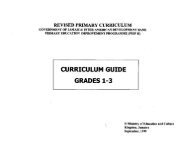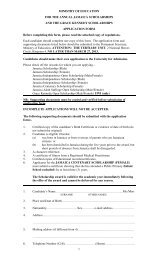Critical Incident Manual - Ministry of Education
Critical Incident Manual - Ministry of Education
Critical Incident Manual - Ministry of Education
You also want an ePaper? Increase the reach of your titles
YUMPU automatically turns print PDFs into web optimized ePapers that Google loves.
Guidelines for Developing a <strong>Critical</strong> <strong>Incident</strong> Management Plan for a Safe School EnvironmentThe mentoring programme developed within the school should assist students by:• Providing opportunities for advice and counselling.• Identifying and linking students with youth friendly programmes.• Helping students to work out a personal plan <strong>of</strong> action.• Providing access to reading programmes and homework facilities.• Promoting personal growth, academic achievement and career development.Development and TrainingAppropriate training for students and staff is important in transforming school into a peacefuland safe place in which teaching and learning can take place. Thus annual ongoing in-servicetraining <strong>of</strong> school personnel is very important. Schools will identify their training needs andseek to incorporate participatory strategies in the delivery <strong>of</strong> the training.Participatory DevelopmentAchieving the goal <strong>of</strong> creating and maintaining a safe school climate will necessitate apartnership <strong>of</strong> school, home and community. The schools’ CIMP programme by necessitymust be extended to the family and community. This will allow for the reinforcement <strong>of</strong> theprinciples and skills <strong>of</strong> non-violence education as part <strong>of</strong> everyday life. Students will alsohelp adults to acknowledge the negative impact violence in the community has upon their lifechances and long-term mental health. School and community can form valuable partnershipsthrough the PTA, community based groups and community policing.Assessment: Formative and Summative Evaluation <strong>of</strong>the Overall PlanResearch has shown that a properly executed plan can serve to unite school, staff andcommunity for a common purpose and is the first step in a prevention programme. A needsassessment will help the school determine its priority needs, and determine availableresources.The needs assessment should help to determine the following:• The extent to which conflicts/violence interferes with teaching and learning.• The number and nature <strong>of</strong> conflicts.• Perception <strong>of</strong> school climate and safety at school plant and surroundings.• The type <strong>of</strong> conflicts that are student-student, or staff-student.• The effectiveness <strong>of</strong> disciplinary procedures.• Existing attitudes and practices that will facilitate/hinder programme implementation.• People who can provide training and skills in conflict resolution/staff development.<strong>Ministry</strong> <strong>of</strong> <strong>Education</strong> 2007 / 46
















